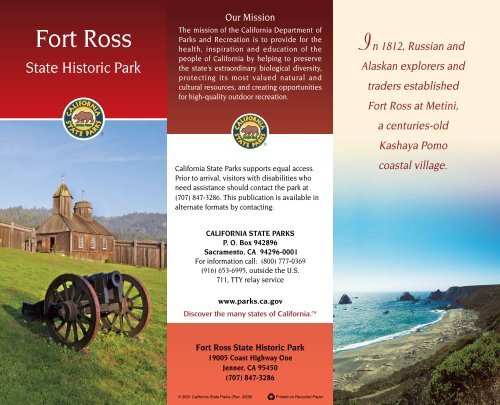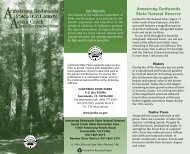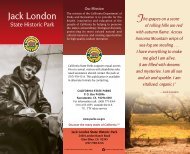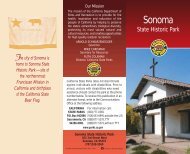Download the Official Fort Ross State Historic Park Map/Brochure
Download the Official Fort Ross State Historic Park Map/Brochure
Download the Official Fort Ross State Historic Park Map/Brochure
You also want an ePaper? Increase the reach of your titles
YUMPU automatically turns print PDFs into web optimized ePapers that Google loves.
<strong>Fort</strong> <strong>Ross</strong><br />
<strong>State</strong> <strong>Historic</strong> <strong>Park</strong><br />
Our Mission<br />
The mission of <strong>the</strong> California Department of<br />
<strong>Park</strong>s and Recreation is to provide for <strong>the</strong><br />
health, inspiration and education of <strong>the</strong><br />
people of California by helping to preserve<br />
<strong>the</strong> state’s extraordinary biological diversity,<br />
protecting its most valued natural and<br />
cultural resources, and creating opportunities<br />
for high-quality outdoor recreation.<br />
California <strong>State</strong> <strong>Park</strong>s supports equal access.<br />
Prior to arrival, visitors with disabilities who<br />
need assistance should contact <strong>the</strong> park at<br />
(707) 847-3286. This publication is available in<br />
alternate formats by contacting:<br />
In 1812, Russian and<br />
Alaskan explorers and<br />
traders established<br />
<strong>Fort</strong> <strong>Ross</strong> at Metini,<br />
a centuries-old<br />
Kashaya Pomo<br />
coastal village.<br />
CALIFORNIA STATE PARKS<br />
P. O. Box 942896<br />
Sacramento, CA 94296-0001<br />
For information call: (800) 777-0369<br />
(916) 653-6995, outside <strong>the</strong> U.S.<br />
711, TTY relay service<br />
www.parks.ca.gov<br />
Discover <strong>the</strong> many states of California.<br />
<strong>Fort</strong> <strong>Ross</strong> <strong>State</strong> <strong>Historic</strong> <strong>Park</strong><br />
19005 Coast Highway One<br />
Jenner, CA 95450<br />
(707) 847-3286<br />
© 2001 California <strong>State</strong> <strong>Park</strong>s (Rev. 2008)<br />
Printed on Recycled Paper
F ort <strong>Ross</strong> <strong>State</strong> <strong>Historic</strong> <strong>Park</strong>, one of<br />
<strong>the</strong> oldest parks in <strong>the</strong> California <strong>State</strong> <strong>Park</strong><br />
System, was established in 1906. Located<br />
on <strong>the</strong> Sonoma coast 11 miles northwest of<br />
Jenner on Highway One, <strong>the</strong> 3,386-acre park<br />
preserves North America’s sou<strong>the</strong>rnmost<br />
Russian settlement. The <strong>Fort</strong> <strong>Ross</strong> Colony<br />
was founded in 1812 by members of <strong>the</strong><br />
Russian-American Company, who built it<br />
with <strong>the</strong> help of Alaskan Alutiiq natives.<br />
North of <strong>the</strong> fort, <strong>the</strong> old Call Ranch house<br />
and buildings represent <strong>the</strong> American ranch<br />
era, which followed <strong>the</strong> Russian settlement.<br />
<strong>Park</strong> facilities include a visitor center with<br />
interpretive exhibits, a museum bookstore,<br />
gardens, <strong>the</strong> Russian Cemetery, <strong>the</strong> Old<br />
Russian Orchard, and a research library. The<br />
fort and its buildings have a sweeping view<br />
of <strong>the</strong> Pacific Ocean, coastal terraces and<br />
densely forested ridges.<br />
Winter storms frequently batter <strong>the</strong><br />
coastline with gale-force winds. Normal<br />
annual rainfall averages 44 inches, with<br />
35 inches falling between November and<br />
April. Spring can be windy, and summer<br />
often brings a thick layer of fog. Visitors are<br />
advised to dress warmly in layers and to<br />
wear sturdy shoes.<br />
PARK HISTORY<br />
Native People<br />
Metini was a village between <strong>the</strong> Gualala<br />
River and <strong>the</strong> Russian River that had been<br />
occupied for centuries by <strong>the</strong> Kashaya band<br />
of Pomo people. The Kashaya Pomo would<br />
seasonally move <strong>the</strong>ir village from <strong>the</strong> ridges<br />
where <strong>the</strong>y lived in winter, to <strong>the</strong>ir summer<br />
home at <strong>the</strong> seashore, hunting and ga<strong>the</strong>ring<br />
food from <strong>the</strong> ocean and <strong>the</strong> land. Along<br />
<strong>the</strong> shore, <strong>the</strong>y found plentiful supplies of<br />
abalone, mussels, fish and a rich variety of<br />
sea plants. The Kashaya harvested sea salt<br />
for domestic use and trading. Plants, acorns,<br />
deer and smaller mammals provided an<br />
abundance of foods inland. The natives used<br />
resources only as needed, ensuring that<br />
plants and wildlife would be conserved for<br />
future generations.<br />
The Kashaya excelled in <strong>the</strong> art of basket<br />
making. Using wooly sedge grass and bulrush<br />
roots, redwood bark, willow and redbud<br />
branches, <strong>the</strong>y wove intricate containers<br />
used for cooking and storing food, trapping<br />
fish or animals, toys, cradles, gifts and<br />
ceremonies. The baskets were colored with<br />
wild walnut juice and berries and decorated<br />
with fea<strong>the</strong>rs. One prized fea<strong>the</strong>r came from<br />
<strong>the</strong> red spot on a red-winged blackbird.<br />
The Kashaya bartered with <strong>the</strong> neighboring<br />
Coast Miwok, who lived south of <strong>the</strong> Russian<br />
River near Bodega Bay. Kashaya first<br />
encountered non-natives when Russians<br />
settled at Metini.<br />
Russians in North America<br />
Beginning in 1742, Russian “promyshlenniki”<br />
(frontiersmen) began to leave <strong>the</strong> Siberian<br />
mainland to seek fur-bearing marine<br />
mammals on and near <strong>the</strong> many islands to<br />
<strong>the</strong> east. In 1784 Gregor Shelikov built <strong>the</strong><br />
first permanent Russian settlement on<br />
Kodiak Island, in what is now Alaska. The<br />
organization he led became <strong>the</strong> Russian-<br />
American Company in 1799, when Tsar<br />
Paul granted <strong>the</strong> company a charter giving<br />
it monopoly over all Russian enterprises<br />
in North America. The Russian-American<br />
Company established colonies from<br />
Kodiak Island to Sitka in present-day<br />
Alaska, as well as in Hawaii. The operation<br />
expanded when American ship captains<br />
contracted with <strong>the</strong> Russian-American<br />
Company for joint ventures, using native<br />
Alaskans to hunt sea otters along <strong>the</strong> coast<br />
of Alta and Baja California. Otter pelts were<br />
highly valued in trade with China, and large<br />
profits flowed to company shareholders,<br />
including members of <strong>the</strong> Russian nobility.<br />
Artifacts of settlement life
The Russia-American Company’s<br />
Alexander Baranov sent his manager Ivan<br />
Kuskov to locate a California site that could<br />
serve as a trading base. Kuskov arrived in<br />
Bodega Bay on <strong>the</strong> ship Kodiak in January of<br />
1809 and remained until late August. He and<br />
his party of 40 Russians and 150 Alaskans<br />
explored <strong>the</strong> entire region, taking more than<br />
2,000 sea otter pelts back to Alaska.<br />
Kuskov returned to California to establish<br />
a Russian outpost at Metini, 18 miles north<br />
of Bodega. The site had plentiful water, good<br />
soil, forage and pasture, and a nearby supply<br />
of redwood for construction. The village’s<br />
relative inaccessibility from <strong>the</strong> Spanishoccupied<br />
territory to <strong>the</strong> south also gave <strong>the</strong><br />
settlers a defensive advantage.<br />
Ivan Kuskov,<br />
first manager of <strong>Fort</strong> <strong>Ross</strong><br />
In 1812 Kuskov<br />
brought 25<br />
Russians and<br />
80 Alaskans to<br />
build houses<br />
and a stockade,<br />
establishing a<br />
colony to grow<br />
wheat and o<strong>the</strong>r<br />
crops for Russians<br />
living in Alaska,<br />
hunt marine<br />
mammals, and<br />
trade with Spanish California. On August 13,<br />
1812, <strong>the</strong> colony was formally dedicated and<br />
renamed “<strong>Ross</strong>” to honor its connection with<br />
Imperial Russia—or “<strong>Ross</strong>iia.” The colonists<br />
called <strong>the</strong>ir new home <strong>Fort</strong>ress <strong>Ross</strong> or<br />
settlement <strong>Ross</strong>.<br />
Life at <strong>the</strong> <strong>Ross</strong> Colony<br />
The newcomers built redwood structures<br />
and a wooden palisade with two cannonfortified<br />
blockhouses on <strong>the</strong> north and<br />
south corners. A well in <strong>the</strong> center of <strong>the</strong><br />
fort provided emergency water. The bell<br />
tower stood in <strong>the</strong> east corner; <strong>the</strong> interior<br />
contained <strong>the</strong> manager’s two-story house,<br />
<strong>the</strong> clerks’ quarters, artisans’ workshops,<br />
and Russian officials’ barracks.<br />
In <strong>the</strong> mid-1820s, <strong>the</strong> chapel<br />
was built. Outside <strong>the</strong> stockade<br />
to <strong>the</strong> northwest, lower-ranking<br />
employees and people of mixed<br />
ancestry gradually established a<br />
village, and to<br />
<strong>the</strong> southwest<br />
<strong>the</strong> native<br />
Alaskans<br />
lived in<br />
ano<strong>the</strong>r<br />
village on a<br />
bluff above<br />
<strong>the</strong> ocean.<br />
The only<br />
surviving<br />
original<br />
structure at<br />
<strong>Fort</strong> <strong>Ross</strong> is <strong>the</strong> Rotchev House, an e xisting<br />
building renovated for Alexander Rotchev,<br />
<strong>the</strong> last manager of <strong>Ross</strong>. Several o<strong>the</strong>r<br />
buildings have been reconstructed: <strong>the</strong> first<br />
Russian Orthodox chapel south of Alaska,<br />
<strong>the</strong> stockade, and four o<strong>the</strong>r buildings—<strong>the</strong><br />
first manager’s home (Kuskov House),<br />
<strong>the</strong> <strong>Official</strong>s’ Barracks, and two corner<br />
blockhouses.<br />
Only a small number of Russians lived<br />
at <strong>Ross</strong>; few were women. <strong>Ross</strong> was a<br />
successfully functioning multicultural<br />
settlement for at least thirty years. Settlers<br />
included Russians, Native Alaskans and<br />
Californians, and Creoles (individuals of<br />
mixed European and native ancestry).<br />
In addition to agriculture and hunting sea<br />
mammals, <strong>Ross</strong> colony industries included<br />
blacksmithing, tanning, brickmaking<br />
and shipbuilding. The first ship built in<br />
California, Rumiantsev, was completed<br />
Russian flag over <strong>the</strong> Rotchev House
in 1818. Gophers, coastal fog and lack of<br />
farming experience eventually thwarted <strong>the</strong><br />
Russians’ agricultural efforts.<br />
By 1820 <strong>the</strong> marine mammal population<br />
was depleted from over-hunting by <strong>the</strong><br />
Americans, Spanish, and Russians. The<br />
Russian-American Company subsequently<br />
introduced hunting moratoriums on seals<br />
and otters, establishing <strong>the</strong> first marinemammal<br />
conservation laws in <strong>the</strong> Pacific.<br />
Russians had contributed to California’s<br />
scientific knowledge through voyages<br />
that studied geography, cartography,<br />
ethnography, geology, meteorology,<br />
hydrography, botany and biology. Russian<br />
voyages brought about many early charts<br />
of California’s north coast. In 1840 Russian<br />
naturalist and artist Ilya Voznesenskii spent<br />
a year at <strong>Ross</strong>, ga<strong>the</strong>ring specimens of<br />
California’s flora and fauna, as well as an<br />
invaluable ethnographic collection of such<br />
native California artifacts as <strong>the</strong> acclaimed<br />
Kashaya Pomo baskets. Many of <strong>the</strong>se<br />
specimens are displayed today in <strong>the</strong><br />
Peter <strong>the</strong> Great Kunskamera Museum in St.<br />
Petersburg, Russia.<br />
The Post-Russian Period<br />
In December 1841, <strong>the</strong> Russian-American<br />
Company sold <strong>Fort</strong> <strong>Ross</strong> holdings to John<br />
Sutter, who sent his trusted assistant John<br />
Bidwell to ga<strong>the</strong>r up <strong>the</strong> <strong>Ross</strong> hardware,<br />
cattle, sheep and o<strong>the</strong>r animals and<br />
transport <strong>the</strong>m to Sacramento Valley, where<br />
Sutter had built his own fort. In 1843 William<br />
Otto Benitz arrived to manage <strong>Fort</strong> <strong>Ross</strong> for<br />
Sutter; later he acquired <strong>the</strong> adjacent land<br />
and lived <strong>the</strong>re with his family until 1867. He<br />
sold <strong>the</strong> property to James Dixon and Lord<br />
Fairfax, who ran a lumber operation until 1872.<br />
George W. Call purchased <strong>the</strong> land in 1873,<br />
establishing <strong>the</strong> 15,000-acre Call Ranch, which<br />
exported cordwood, railroad ties, fence posts,<br />
tanbark, apples and dairy products well into<br />
<strong>the</strong> 20th century. They loaded <strong>the</strong>ir cargo onto<br />
vessels anchored at <strong>the</strong> wharf in <strong>the</strong> sheltered<br />
cove below by use of a chute that carried bulk<br />
cargo directly onto <strong>the</strong> ships. The Calls owned<br />
<strong>the</strong> ranch property until 1973.<br />
In 1903 <strong>the</strong> California <strong>Historic</strong>al Landmarks<br />
Committee purchased <strong>the</strong> <strong>Ross</strong> stockade<br />
area from <strong>the</strong> Call family, and <strong>the</strong> <strong>State</strong> of<br />
California acquired <strong>the</strong> site in 1906. California<br />
<strong>State</strong> <strong>Park</strong>s has done extensive restoration<br />
and reconstruction, and more acreage has<br />
been added to preserve <strong>the</strong> surrounding<br />
environment. The Rotchev House has<br />
been designated a National<br />
<strong>Historic</strong> Landmark.<br />
NATURAL HISTORY<br />
<strong>Fort</strong> <strong>Ross</strong> is located on a<br />
wave-cut marine terrace<br />
between <strong>the</strong> ocean to<br />
<strong>the</strong> southwest and high,<br />
forested hills to <strong>the</strong><br />
nor<strong>the</strong>ast. Steep bluffs<br />
drop several hundred<br />
feet into <strong>the</strong> sea to <strong>the</strong><br />
sou<strong>the</strong>ast. Below <strong>the</strong> fort,<br />
sheltered Sandy Cove<br />
features a serene beach<br />
Great blue heron<br />
and still waters. <strong>Fort</strong> <strong>Ross</strong> Creek flows over<br />
two miles northwesterly to Sandy Cove.<br />
Redwood and coniferous forests,<br />
grasslands, scrub, and coastal strand make<br />
up <strong>the</strong> park’s four distinct vegetation<br />
types. The upland slopes are covered in<br />
bishop pine and Douglas fir, while <strong>the</strong><br />
coastal shelf is open grassland. Protected<br />
hollows and ravines shelter stands of oldand<br />
second-growth redwoods.<br />
Diverse wildlife species live at <strong>Fort</strong> <strong>Ross</strong>.<br />
Visitors may encounter grey foxes and<br />
black-tailed hares. Mountain lions<br />
and bobcats live in <strong>the</strong> area. Marine<br />
m ammals include harbor seals, sea lions<br />
and m igrating grey whales. Birdwatchers<br />
may find osprey, r ed-tailed and redshouldered<br />
hawks, kestrels, herons or<br />
o<strong>the</strong>r shore birds.<br />
Interpretive PROgrams<br />
Interpretive presentations and<br />
educational programs are offered<br />
on most days. For more information or a<br />
schedule, please call (707) 847-4777 or<br />
visit www.parks.ca.gov<br />
RECREATIONAL ACTIVITIES<br />
Camping—Open from April through<br />
November, <strong>the</strong> Reef C ampground has 21<br />
primitive campsites in a wind-protected<br />
canyon. Tables, stoves, and food lockers<br />
are available, with flush toilets and<br />
drinking water spigots nearby. No showers<br />
are available. Reef Campground is two<br />
miles south of <strong>Fort</strong> <strong>Ross</strong> on Highway One.
Russian cemetery<br />
Picnicking—Tables are located near <strong>the</strong><br />
Visitor Center, <strong>the</strong> Call Ranch House, in<br />
<strong>the</strong> historic compound, and at Sandy Cove<br />
beach.<br />
Trails—Pedestrian trails lead to Sandy<br />
Cove Beach from <strong>the</strong> Reef Campground,<br />
<strong>the</strong> fort stockade and from <strong>the</strong> Russian<br />
Cemetery. A marked trail leads from <strong>the</strong><br />
orchard to <strong>the</strong> Stanley Spyra Memorial<br />
Grove.<br />
Fishing—Abalone and rockfish abound in <strong>the</strong><br />
coastal waters in season. Anglers aged 16 and<br />
over must possess a valid California fishing<br />
license. All abalone divers must adhere to<br />
current legal limits and carry a current Abalone<br />
Report Card.<br />
Diving—Certified scuba divers can explore<br />
<strong>the</strong> wreck of <strong>the</strong> S.S. Pomona, a ship that sank<br />
over 100 years ago off <strong>Fort</strong> <strong>Ross</strong> Cove.<br />
Dive and swim at your own risk. Always dive<br />
with a buddy and exercise caution in <strong>the</strong><br />
ocean. Hazardous rip currents and large waves<br />
can appear out of nowhere and sweep unsuspecting<br />
visitors out to sea. Never turn your<br />
back to <strong>the</strong> waves. No lifeguards are on duty.<br />
ACCESSIBLE FEATURES<br />
<strong>Park</strong>ing and <strong>the</strong> visitor center are fully accessible.<br />
The fort compound has limited accessibility.<br />
For updated information, call <strong>the</strong> park at<br />
(707) 847-3286 or see<br />
http://access.parks.ca.gov.<br />
NEARBY STATE PARKS<br />
• Salt Point <strong>State</strong> <strong>Park</strong>/Kruse Rhododendron<br />
<strong>State</strong> Reserve—8 miles north on Highway<br />
One (707) 847-3221<br />
• Sonoma Coast <strong>State</strong> <strong>Park</strong>—14 miles south<br />
on Highway One (707) 875-3483<br />
Please Remember<br />
• <strong>Park</strong> grounds open 1/2 hour before sun<br />
rise and close 1/2 hour after sunset.<br />
The <strong>Fort</strong> and Visitor Center are open<br />
from 10 - 4.<br />
• Stay on designated trails to protect<br />
plants, prevent erosion and avoid<br />
poison oak.<br />
• Dogs are allowed only in <strong>the</strong> main<br />
parking area and in <strong>the</strong> campground.<br />
They must be on a six-foot leash at all<br />
times and remain in a tent or vehicle<br />
at night.<br />
• Alcoholic beverages are not allowed in<br />
<strong>the</strong> park, and fires and glass containers<br />
are not allowed on <strong>the</strong> beach.<br />
• All park natural and cultural resources<br />
are protected and must not be<br />
disturbed or removed.<br />
This park receives support in part<br />
through a nonprofit association.<br />
For more information, contact:<br />
<strong>Fort</strong> <strong>Ross</strong> Interpretive Association, Inc.<br />
19005 Coast Highway One, Jenner, CA 95450<br />
(707) 847-3437<br />
www.fortrossinterpretive.org<br />
Settlement <strong>Ross</strong>, 1841 by I.G. Voznesenskii






